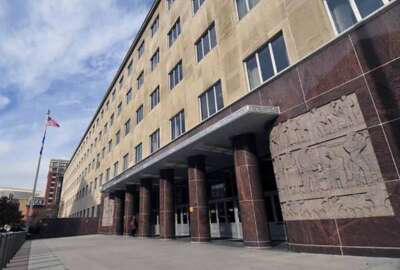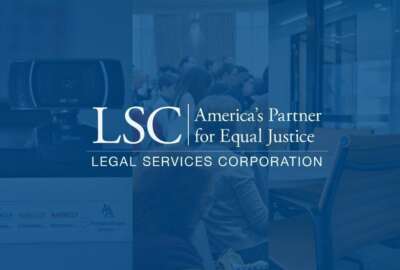The nation’s funder of legal aid services gets a new inspector general
A seasoned overseer of federal grant-making has returned to government. After a stint at a large services contractor, he recently became the inspector general at...
A seasoned overseer of federal grant-making has returned to government. After a stint at a large services contractor, he recently became the inspector general at the Legal Services Corporation, one of the more unusual federal structures. Federal Drive with Tom Temin has this conversation with Tom Yatsco.
Interview Transcript:
Tom Temin And let’s talk about the Legal Services Corporation. It’s kind of a unique animal. You might think it’s part of the Justice Department, but actually it’s independent and it’s not precisely an agency.
Tom Yatsco No, it’s really not. It was set up by Congress almost 50 years ago. The anniversary is next year, so everyone’s very excited about that. But it’s technically a private nonprofit corporation chartered by Congress. It’s largely federally funded like 90 plus percent. It provides grants to civil legal aid organizations for things like housing, family issues, consumer issues. They’re very strict limitations on what LSC funds can be used for. Pretty much anything controversial, abortion, lobbying, redistricting things like that. It was set up to be as apolitical as possible. And there are 130 grantees all across the country, including in U.S. territories. And it’s run by a board of directors of 11 members who are nominated by the president, confirmed by the Senate. And no more than six can be of one party. So it also was intended to be a bipartisan board. And then later on, just like some other kind of designated federal entities like Amtrak, Pension Benefits Guaranty Corporation, the Fed was required to have an inspector general. So what I do is just like what the HUD IG would do or the Justice IG, for example, would do. Efficiency, effectiveness, investigate allegations of fraud and so forth.
Tom Temin And just to get back to the mission. So the grantees then provide legal services to the poor for dealing with certain issues?
Tom Yatsco Correct. For civil legal issues for low income Americans, generally, 125% of the federal poverty limit and below. And yes, the grants go to state and local based legal aid organizations that are, like I said, all over the country. And ranging from very large ones in places like L.A. or New York to pretty small organizations.
Tom Temin Can they be units within law firms that want to do close to pro bono type of work?
Tom Yatsco I think there’s separate legal aid organizations. I knew enough not to know too much about the intricacies. I’m looking forward to getting out into the field this fall and really seeing how it all plays out at ground level. But there’s also a big push for pro bono work as well. And I think we’ll see actually funds some activities in that regard.
Tom Temin And being a veteran of grant making oversight, we’ll get into some of your background a little bit in a moment. But what are the special oversight requirements for grants versus, say, contract making, which is the other big spending channel?
Tom Yatsco Yeah. One year we’re responsible for LSC oversight and they’re responsible for monitoring their grantees. So some of the things that we find are typical for any grant making organization that people, segregation of duties, misuse of credit cards, of course not using grants for authorized purposes. LSC has a whole set of regulations at Title 45 that grantees must follow. So those are the criteria that we use, just like any grant making agency would have their regulations. Recipient monitoring is always an issue when you get down a level below the grantees, and LSC has some recipient grantees. That’s always been an issue everywhere I have worked. Particularly with grantees, they’re very passionate about the mission and what they do. And sometimes with the best of intentions, things like internal controls, monitoring, adopting new practices are kind of secondary or even tertiary considerations. And I think that’s what we add value is kind of, you know, lifting them out of the day to day in the weeds and identifying not just compliance issue in a backward looking way, but also like anticipating and advising them on ways to improve, ways to adopt promising practices that other agencies or organizations are using. And I think we can play a lot of value, and not beyond just the traditional essential watchdog role. That’s something coming on as the new IG that I’m really pushing as part of my vision.
Tom Temin We’re speaking with Tom Yatsco. He is the newly appointed inspector general at the Legal Services Corporation. And what attracted you to come back to government? You worked at Deloitte Touche for a long time, and before that at USAID as the IG assistant inspector general. And you’ve been involved with CGI and all of the other structures. Tell us about Deloitte and what made you want to come back to government.
Tom Yatsco Deloitte experience was interesting and I really liked it. I just thought it was time to try something new. I was working on internal audit at Deloitte and also then helping federal clients with audit remediation and kind of preventing problems that GAO or their IG would find. But there is that term at Deloitte called what’s your North Star? And so I just figured IG world is what I do, and I just started seeing what IG vacancies might be out there. And LSC came into my life and I’m glad it did. And everything worked out well. And it’s great now to have the top job, and also move beyond just auditing and evaluation, but have all of the investigations and the hotline and everything. And yeah, it just seemed very exciting and a way that I would want to spend the rest of my career.
Tom Temin Got it. And what are the dollar levels that LSC is overseeing that you’re overseeing?
Tom Yatsco LSC is federal appropriation this year was $560 million and it does get a little pots of money here and there. So it got some pandemic funding, It got some money in the last few natural disaster supplemental grants, which create a lot of legal issues for low income Americans with floods and hurricanes and so forth. So it takes up above that a bit. But it’s 500 to 600 million a year. And certainly the needs are much greater than that in the last budget request. LSC management asked for 1.5 billion to be able to cover what was envisioned in the LSC Act back in the seventies. So the idea of the justice gap, as they say is a real thing.
Tom Temin Sure. And getting back to your own career too, you have been in a lot of places, including [Government Accountability Office (GAO)], which is the congressional branch. It all has oversight theme. But you started out of the kind of the granddaddy of oversight.
Tom Yatsco Well, a lot of people do that. I’m sure you’ve heard it in the different interviews you’ve done over many years. People kind of go from GAO into the IG community since it’s sort of like the IGs really are almost like mini GAO’s within the agency. You do performance auditing, you’re doing financial auditing and so forth. So you use all the skills and experience you have. It’s just a little more direct because of course you’re part of the agency. You have independent safeguards and so forth. But you’re within it. That appealed to me when I made the jump from GAO into working at the several IG’s that I worked at.
Tom Temin And in the short time at the LSC. Any horror stories yet?
Tom Yatsco No. the investigations are always laugh or cry situations when you see like the biweekly report of what everyone’s working on. But no, the people have been great. The board of directors is very engaged. They have quarterly meetings that are sort of two and a half day, really intense affairs. Some of it is publicly watchable, because the Sunshine Act is one of the few federal laws that do apply to LSC. So people can watch the proceedings there. But no horror stories, other than I’m really glad I did this and I’m excited to be back kind of doing what I love doing. And it’s a great team too, within the IG.
Copyright © 2025 Federal News Network. All rights reserved. This website is not intended for users located within the European Economic Area.
Tom Temin is host of the Federal Drive and has been providing insight on federal technology and management issues for more than 30 years.
Follow @tteminWFED





